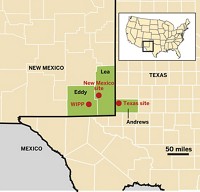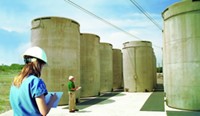Advertisement
Grab your lab coat. Let's get started
Welcome!
Welcome!
Create an account below to get 6 C&EN articles per month, receive newsletters and more - all free.
It seems this is your first time logging in online. Please enter the following information to continue.
As an ACS member you automatically get access to this site. All we need is few more details to create your reading experience.
Not you? Sign in with a different account.
Not you? Sign in with a different account.
ERROR 1
ERROR 1
ERROR 2
ERROR 2
ERROR 2
ERROR 2
ERROR 2
Password and Confirm password must match.
If you have an ACS member number, please enter it here so we can link this account to your membership. (optional)
ERROR 2
ACS values your privacy. By submitting your information, you are gaining access to C&EN and subscribing to our weekly newsletter. We use the information you provide to make your reading experience better, and we will never sell your data to third party members.
Environment
DOE Falls Behind In Cleanups
Cleanup of nuclear weapons sites is behind schedule and over budget, audit shows, but DOE cuts program
by Jeff Johnson
March 10, 2008
| A version of this story appeared in
Volume 86, Issue 10

OPTIMISTIC MILESTONES in cleaning up the nuclear weapons complex cannot be met, the Department of Energy recently announced. With much fanfare, the Bush Administration set milestones just a few years ago. Now, DOE must begin renegotiating agreements reached with states to reflect new and more accurate costs and schedules revealed last year in a program-wide audit, says Assistant Secretary James A. Rispoli, who manages the agency's cleanup program.
The audit shows that the cost to clean up extensive radioactive and hazardous waste contamination is likely to be as high as $305 billion, more than $50 billion higher than the Administration's earlier estimate. It also may take until 2062 to finish the job—more than 20 years longer than original estimates. Yet this year's cleanup budget proposal is $5.5 billion, the lowest level in the last 15 years for the huge cleanup program.
Former energy secretary Spencer Abraham set the earlier milestones in 2002 as part of his "accelerated cleanup plan." The plan was based on a top-to-bottom review of the overall cleanup program, Abraham said at the time.
In 2002, Abraham said: "When I became energy secretary, a little more than a year ago today, I was presented with the old plan for cleaning up our sites, which called for a timetable of some 70 years to complete and at a cost of $300 billion. That is not good enough for me, and I doubt it is good enough for anyone who lives near these sites."
Abraham then announced his new plan to cut the program by at least $50 billion and to complete cleanups at nearly all sites by 2035. His plan required state and local officials where the contaminated sites are located to agree to accelerate cleanups and in return the state would receive adequate funding. At the time, some local officials called the plan "blackmail" and complained that cleanup standards would be lowered in return for receiving funds for the cleanup. But they went along and revised their cleanup plans (C&EN, March 25, 2002, page 12).
Now, in the Bush Administration's final year, cleanup schedules and costs for most sites are back where they were when the Administration took office.

FOR MORE THAN 20 YEARS, people living near some 100 sites where U.S. nuclear weapons materials had been manufactured have complained of contamination and health hazards from radioactive and hazardous waste left at the sites. Progress has been made, but cleanups at the largest and most complicated sites, such as Hanford in Washington, Savannah River in South Carolina, and Idaho National Laboratory, have plodded along. Cleanup of these sites is highly complex technologically, and the sites are extremely expensive to remediate. Their cleanup schedules remain many decades away from completion.
Rispoli brought the bad news to a national meeting of the Energy Community Alliance, an organization of elected officials living in communities near the sites, on Feb. 22. But the news wasn't all bad, Rispoli stressed to the disappointed officials. He pointed out that the Bush Administration's cleanup program had reduced the number of sites to 24. In particular, he singled out completed cleanups at three former weapons sites: Rocky Flats site in Colorado and Fernald and Miamisburg sites in Ohio.
However, the 24 sites that remain on the list are the thorniest and by far the most expensive cleanups.
Rispoli blamed the need to negotiate new milestones on "incomplete knowledge of the cleanup's complexity, inconsistent performance on technical issues, and risks that materialized and had not been allowed for. There were overly optimistic assumptions and barriers that no one saw."
"State regulators are not happy," Rispoli acknowledged. Over the years many states have signed agreements with DOE and the Environmental Protection Agency that include cleanup milestones. Many of these milestones must be renegotiated, he said, because they cannot be reached with the budget just proposed by the Bush Administration.
"I believe because we have solid relationships with regulators, and because we now have independent audits, we will be able to work with regulators to shuffle priorities to determine what goes and what stays," Rispoli said. "Not all milestones are created equal."
Rispoli would not identify the milestones that can't be met, saying DOE is just beginning to discuss them with state officials. He said, however, that some 25 specific milestones are in jeopardy.
States are not likely to go along quietly. A week ago, Washington Gov. Christine Gregoire (D) threatened to sue over missed milestones after a meeting with Energy Secretary Samuel W. Bodman. Gregoire had been state attorney general when the earlier agreements were reached.
At the least, states and local communities will lean hard on their federal congressional delegations to restore cleanup funds cut by the Administration.
This latest reassessment joins a long run of revised cleanup plans stretching back to the start of the cleanup program in the late 1980s. This most recent revision is unique because this Administration is rejecting its own estimates, rather than those of its predecessor, which has been the usual case.
"I think I heard that speech 10 years ago," said a participant at the Feb. 22 meeting. Several local officials warned that the time extension and reduced budget make it more likely that big sites like Hanford, whose cleanup is estimated to cost one-third of the $305 billion and take the longest time, will be simply fenced off and never cleaned up.
"We have seen this coming," said Pamela Brown Larsen, executive director of Hanford Communities, a coalition of cities bordering the site. "Although a lot is getting done at Hanford, the problem is that the minimum safe-level costs are so high. Just keeping the lights on and keeping everybody safe is expensive," she said, speaking about the facility's 177 old underground storage tanks filled with 53 million gal of radioactive and hazardous wastes, the miles and miles of piping, and thousands of valves. The program to treat these tank wastes has been long stalled, and Larsen noted, "We don't want them to build new, safer tanks because that means they will never treat the waste."
ALTHOUGH HANFORD would get nearly $2 billion in the budget proposal, Larsen said that that amount will only contain the waste and maintain the site. Another $160 million, she said, is needed to "ensure stuff gets done." This fact underscores the expense associated with containing the waste versus cleaning it up.
"Hanford was promised that if Rocky Flats and Fernald were speeded up and closed, the funds they got would go to Hanford," Larsen said. "But that has not been true. DOE forgets that it signed agreements with the states, and elected officials consider these valid deals." Still, she hopes Washington State chooses not to sue. "We know the state government is frustrated, but if it pursues litigation, everything will slip into a quagmire and no work will get done."
Rispoli wasn't around when the accelerated plans were negotiated in 2002, she noted, and now he has his own priorities. Larsen then rattled off the names of past heads of DOE's cleanup programs, each of whom reviewed the program and came up with a new cleanup plan.
"In January, we will get another Rispoli," Larsen added, "and who knows what his plan will be."
The Administration proposed an overall $1 billion increase for DOE compared with last year, Larsen noted. "I am glad the science budget is up and more money is being spent for renewable energy, but I know it had to come from somewhere, and I wish it wasn't from us."






Join the conversation
Contact the reporter
Submit a Letter to the Editor for publication
Engage with us on Twitter